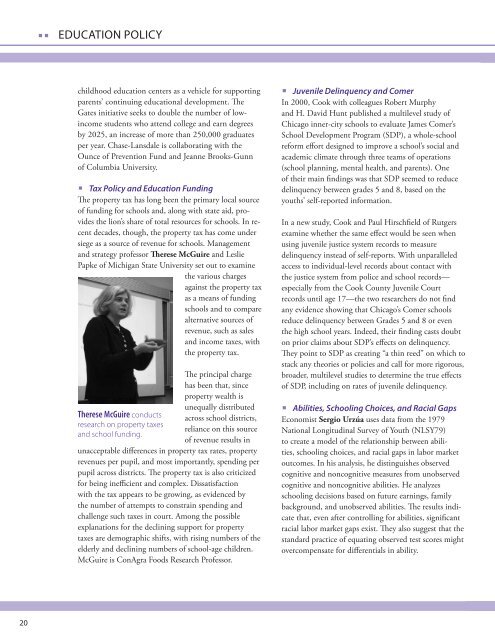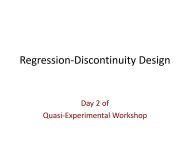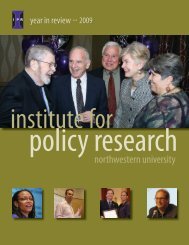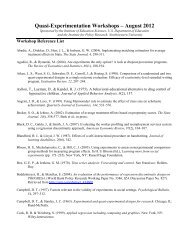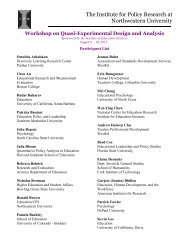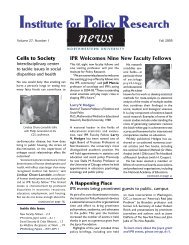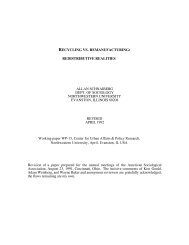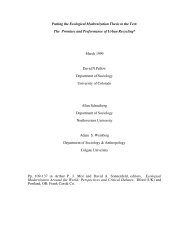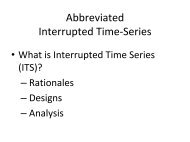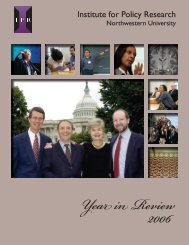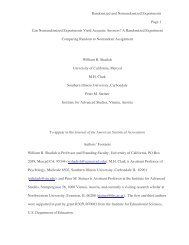IPR - Institute for Policy Research - Northwestern University
IPR - Institute for Policy Research - Northwestern University
IPR - Institute for Policy Research - Northwestern University
Create successful ePaper yourself
Turn your PDF publications into a flip-book with our unique Google optimized e-Paper software.
Education <strong>Policy</strong><br />
childhood education centers as a vehicle <strong>for</strong> supporting<br />
parents’ continuing educational development. The<br />
Gates initiative seeks to double the number of lowincome<br />
students who attend college and earn degrees<br />
by 2025, an increase of more than 250,000 graduates<br />
per year. Chase-Lansdale is collaborating with the<br />
Ounce of Prevention Fund and Jeanne Brooks-Gunn<br />
of Columbia <strong>University</strong>.<br />
< Tax <strong>Policy</strong> and Education Funding<br />
The property tax has long been the primary local source<br />
of funding <strong>for</strong> schools and, along with state aid, provides<br />
the lion’s share of total resources <strong>for</strong> schools. In recent<br />
decades, though, the property tax has come under<br />
siege as a source of revenue <strong>for</strong> schools. Management<br />
and strategy professor Therese McGuire and Leslie<br />
Papke of Michigan State <strong>University</strong> set out to examine<br />
the various charges<br />
against the property tax<br />
as a means of funding<br />
schools and to compare<br />
alternative sources of<br />
revenue, such as sales<br />
and income taxes, with<br />
the property tax.<br />
Therese McGuire conducts<br />
research on property taxes<br />
and school funding.<br />
The principal charge<br />
has been that, since<br />
property wealth is<br />
unequally distributed<br />
across school districts,<br />
reliance on this source<br />
of revenue results in<br />
unacceptable differences in property tax rates, property<br />
revenues per pupil, and most importantly, spending per<br />
pupil across districts. The property tax is also criticized<br />
<strong>for</strong> being inefficient and complex. Dissatisfaction<br />
with the tax appears to be growing, as evidenced by<br />
the number of attempts to constrain spending and<br />
challenge such taxes in court. Among the possible<br />
explanations <strong>for</strong> the declining support <strong>for</strong> property<br />
taxes are demographic shifts, with rising numbers of the<br />
elderly and declining numbers of school-age children.<br />
McGuire is ConAgra Foods <strong>Research</strong> Professor.<br />
< Juvenile Delinquency and Comer<br />
In 2000, Cook with colleagues Robert Murphy<br />
and H. David Hunt published a multilevel study of<br />
Chicago inner-city schools to evaluate James Comer’s<br />
School Development Program (SDP), a whole-school<br />
re<strong>for</strong>m ef<strong>for</strong>t designed to improve a school’s social and<br />
academic climate through three teams of operations<br />
(school planning, mental health, and parents). One<br />
of their main findings was that SDP seemed to reduce<br />
delinquency between grades 5 and 8, based on the<br />
youths’ self-reported in<strong>for</strong>mation.<br />
In a new study, Cook and Paul Hirschfield of Rutgers<br />
examine whether the same effect would be seen when<br />
using juvenile justice system records to measure<br />
delinquency instead of self-reports. With unparalleled<br />
access to individual-level records about contact with<br />
the justice system from police and school records—<br />
especially from the Cook County Juvenile Court<br />
records until age 17—the two researchers do not find<br />
any evidence showing that Chicago’s Comer schools<br />
reduce delinquency between Grades 5 and 8 or even<br />
the high school years. Indeed, their finding casts doubt<br />
on prior claims about SDP’s effects on delinquency.<br />
They point to SDP as creating “a thin reed” on which to<br />
stack any theories or policies and call <strong>for</strong> more rigorous,<br />
broader, multilevel studies to determine the true effects<br />
of SDP, including on rates of juvenile delinquency.<br />
< Abilities, Schooling Choices, and Racial Gaps<br />
Economist Sergio Urzúa uses data from the 1979<br />
National Longitudinal Survey of Youth (NLSY79)<br />
to create a model of the relationship between abilities,<br />
schooling choices, and racial gaps in labor market<br />
outcomes. In his analysis, he distinguishes observed<br />
cognitive and noncognitive measures from unobserved<br />
cognitive and noncognitive abilities. He analyzes<br />
schooling decisions based on future earnings, family<br />
background, and unobserved abilities. The results indicate<br />
that, even after controlling <strong>for</strong> abilities, significant<br />
racial labor market gaps exist. They also suggest that the<br />
standard practice of equating observed test scores might<br />
overcompensate <strong>for</strong> differentials in ability.<br />
20


